Chafing Dish Guide
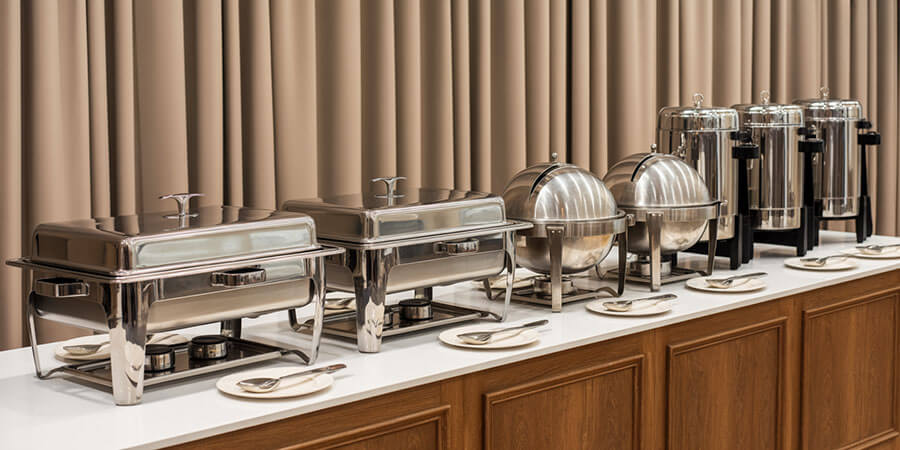
Table of Contents
Essential commercial chafing equipment for buffets and catering
Chafing Dish Overview
Types of Chafing Dishes
Commercial chafing dishes are categorized by shape, lid style, and heating method. Each type serves specific purposes in buffet and catering operations, with capacities ranging from 4 to 11 quarts for different portion needs.
Rectangular Chafing Dishes

Rectangular chafing dishes are the most popular choice for commercial buffets, offering maximum food surface area in standard sizes that fit most steam table openings. The rectangular shape allows for efficient space utilization on buffet lines while providing even heat distribution across large quantities of food.
- Best Uses: Main course buffets, large-volume catered events, hotel banquet service
- Capacities: 7-11 quart full-size models, 4-6 quart half-size options
- Features: Roll-top or dome lids, compatible with standard fuel holders, easy to clean flat surfaces
Round Chafing Dishes

Round chafing dishes provide excellent heat circulation and are ideal for soups, stews, and sauces that benefit from centralized heating. The curved design promotes even warming while taking up less linear space on buffet tables, making them perfect for circular or compact service setups.
- Best Uses: Soup service, sauce stations, specialty catering, beverage service with spouts
- Capacities: 4-11 quart sizes, with 7-8 quart being most common for commercial use
- Features: Dome or roll-top lids, some models include serving spouts for beverages
Square Chafing Dishes

Square chafing dishes offer modern aesthetics and efficient space usage in contemporary catering setups. The geometric design provides clean lines while maintaining the same heating performance as traditional shapes, making them popular for upscale events and modern restaurant buffets.
- Best Uses: Contemporary catering events, modern restaurant buffets, space-conscious banquet halls
- Capacities: 4-8 quart sizes, with 6-7 quart models most practical for commercial service
- Features: Clean geometric design, roll-top lids standard, compatible with induction heating
Oval Chafing Dishes
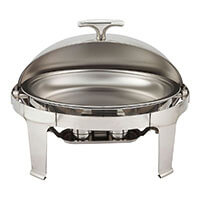
Oval chafing dishes bridge the gap between round and rectangular shapes, offering versatility for different food presentations. The elongated oval design accommodates larger food items or multiple smaller portions while providing the aesthetic appeal needed for special events and wedding catering.
- Best Uses: Wedding receptions, special event catering, mixed menu buffets
- Capacities: 6-8 quart sizes, designed for balanced food presentation
- Features: Elegant oval shape, roll-top lids, premium finish options available
Disposable Chafing Dishes

Disposable chafing dishes feature all of the warming capabilities of standard chafers but are designed for single-use convenience, making them ideal for outdoor events, casual gatherings, or situations where cleanup time is critical. These eco-friendly options eliminate the need for washing and maintenance while providing the same professional warming performance.
- Best Uses: Outdoor weddings, casual catering, one-time events, food truck service
- Capacities: 4-8 quart sizes, various shapes available
- Features: Single-use design, eco-friendly materials, complete setup included, no cleanup required
Chafer Griddles
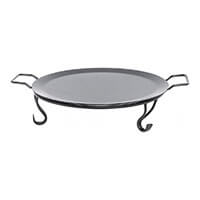
Chafer griddles are specialized chafing units designed for cooking and serving items like pancakes, meats, and vegetables directly on the serving line. They feature raised edges to contain cooking oils and juices while providing the sizzling presentation that enhances the dining experience.
- Best Uses: Breakfast service, action stations, specialty cooking demonstrations
- Features: Built-in griddle surface, raised edges, compatible fuel systems, professional presentation
- Heating: Traditional fuel-based with adjustable flame control for different cooking temperatures
Induction-Ready Chafing Dishes

Induction-ready chafing dishes feature special bases that work with electromagnetic induction cooktops, providing flameless heating with precise temperature control. These modern chafers offer enhanced safety and efficiency for venues with induction-compatible equipment.
- Best Uses: Modern kitchens, hotels with induction equipment, flameless environments
- Capacities: 4-8 quart sizes across all shapes (round, rectangular, square)
- Features: Special induction-compatible bases, precise temperature control, flameless operation
Chafing Fuel & Heaters
The heating system is the heart of any chafing dish setup, with several options available for different operational needs and venue requirements.
Electric Chafing Dish Heaters
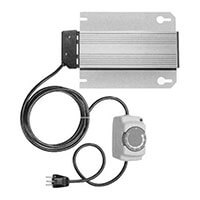
Electric heaters provide flameless, consistent heating through electric coils that warm the water bath beneath the food pan. These heaters offer precise temperature control and are ideal for indoor venues where open flames are prohibited.
- Burn Time: Continuous with proper electrical connection
- Safety: Flameless operation, no fuel handling required
- Best For: Hotels, restaurants, indoor events, modern catering facilities
- Power Requirements: 110-120v standard, some models offer adjustable heat settings
Gel Fuel Chafing Dish Heaters

Gel fuel provides clean-burning, odorless heat in convenient cans that fit standard chafer holders. The gel formulation offers consistent burn times and easy disposal, making it popular for most catering applications.
- Burn Time: 2-3 hours per can, depending on formulation
- Safety: Clean burning, minimal odor, easy to extinguish
- Best For: Outdoor events, traditional catering, banquet halls
- Types: Green ethanol gel, blue methanol gel, each with different burn characteristics
Wick Fuel Chafing Dish Heaters

Wick fuel uses liquid fuel in cans with built-in wicks for adjustable flame control. These traditional heaters offer reliable performance but require proper ventilation and careful handling.
- Burn Time: 2-8 hours depending on fuel type and wick adjustment
- Safety: Adjustable flame, requires ventilation, follow all safety protocols
- Best For: Traditional catering operations, events requiring long burn times
- Fuel Types: Diethylene glycol, ethanol, methanol - check local regulations
Ethanol Chafing Fuel
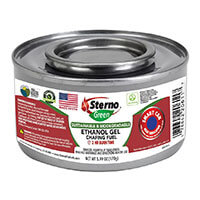
Ethanol fuel provides clean, efficient burning with minimal odor and residue. Available in gel or liquid form, it's becoming increasingly popular for eco-conscious operations and indoor use.
- Burn Time: 2-4 hours per unit, consistent performance
- Safety: Low-toxicity, clean burning, environmentally friendly
- Best For: Green catering, indoor buffets, modern event venues
Beverage Chafing Urns
Specialized chafing dishes designed specifically for hot beverages, these urns feature spouts and enhanced insulation for coffee, tea, and hot chocolate service.
Coffee Chafer Urns
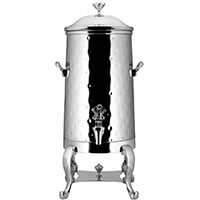
Coffee urns are tall, narrow chafing dishes with built-in spouts designed for hot beverage service. They maintain coffee temperature while allowing easy pouring, making them essential for breakfast buffets and beverage stations.
- Best Uses: Coffee service, tea stations, hot chocolate buffets
- Capacities: 3-10 gallon sizes for different event scales
- Features: Built-in spouts, enhanced insulation, drip-free pouring
Soup Chafer Urns

Soup urns combine the serving convenience of chafing dishes with ladle-friendly designs for thick soups and stews. They feature wider openings and reinforced handles for heavy commercial use.
- Best Uses: Soup buffets, stew service, thick beverage stations
- Capacities: 7-11 quart sizes with reinforced construction
- Features: Wide ladle access, reinforced handles, enhanced stability
Chafing Dish Accessories
Essential supporting equipment that maximizes the functionality and efficiency of chafing dish setups in commercial foodservice operations.
Food Pans & Insets
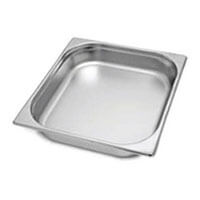
Food pans are the removable containers that hold prepared food within the chafer frame. Available in various depths and shapes, they allow for easy food preparation and service.
- Standard Depths: 2.5", 4", 6" depths for different food volumes
- Materials: Stainless steel for durability, some with non-stick coatings
- Types: Solid pans, perforated pans for draining, compartment pans for multiple items
Water Pans

Water pans hold the heating medium beneath the food pan, with capacities designed to provide even heat distribution without boiling over.
- Function: Contains water or heating medium for consistent heat transfer
- Capacities: Match chafer size - 4-11 quart capacities
- Features: Reinforced rims, easy-to-clean surfaces, stable bases
Chafer Stands & Frames
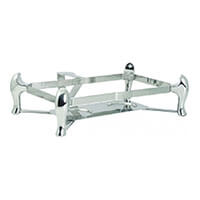
Stands provide stable, elevated platforms for chafers, improving presentation and service accessibility while protecting table surfaces.
- Heights: Standard 6-8" heights, adjustable models available
- Materials: Stainless steel, brass, or decorative finishes
- Features: Folding designs for transport, locking mechanisms for stability
Chafer Lids & Covers

Lids maintain heat and protect food during service, available in clear plastic for visibility or metal for maximum heat retention.
- Types: Roll-top metal lids, dome metal lids, clear plastic covers
- Features: Hinged designs, stay-cool handles, stackable for storage
- Materials: Stainless steel, aluminum, high-temperature plastic
Fuel Holders & Cans
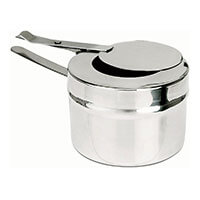
Fuel holders secure heating cans beneath chafers, available in single or double configurations for extended burn times.
- Types: Single fuel holders, double fuel holders for longer service
- Materials: Stainless steel construction, easy-clean surfaces
- Features: Secure locking mechanisms, drip protection, stackable storage
Chafer Storage & Transport

Specialized carts and storage solutions designed for safe transport and organized storage of chafer equipment.
- Storage Bins: Stackable containers for lids, pans, and accessories
- Transport Carts: Wheeled carts for moving multiple chafers
- Features: Reinforced construction, easy-grip handles, secure stacking
Setup & Use Guide
How to Set Up Chafing Dishes
Proper setup ensures optimal performance and food safety. Follow these steps for safe, effective operation:
1. Position the Base: Place the chafer on a stable, heat-resistant surface away from flammable materials and with proper ventilation.
2. Install Water Pan: Place the water pan inside the chafer frame. Fill with hot water to about 2 inches deep - never fill above the minimum mark to prevent overflow.
3. Add Fuel Source:
- Gel Fuel: Place can under water pan with fuel level above water level
- Wick Fuel: Insert can with wick extended, light carefully
- Electric: Plug in and set to desired temperature
- Induction: Ensure compatible base is positioned correctly on induction surface
4. Preheat: Allow 10-15 minutes for water to reach serving temperature (165°F minimum for hot holding).
5. Add Food: Place preheated food in food pans, cover with appropriate lid, and position on water pan.
6. Monitor: Check water levels every hour and maintain fuel as needed. Keep hot food above 135°F.
Fuel Safety Guidelines
| Safety Requirement: | Description: |
| Storage | Store fuel in cool, well-ventilated areas away from heat sources |
| Ventilation | Use fuel in well-ventilated spaces only - never indoors without proper exhaust |
| Clearance | Keep open flames away from flammable materials (minimum 2-foot clearance) |
| Supervision | Never leave burning fuel unattended |
| Fire Safety | Use appropriate extinguishers for fuel fires (Class B fire extinguishers) |
| Compliance | Follow all local fire codes and OSHA requirements for fuel storage and handling |
Maintenance & Cleaning
- Clean chafers immediately after use while still warm for easier removal of food residue
- Wash food pans and water pans in hot, soapy water or dishwasher-safe models
- Dry completely to prevent corrosion
- Polish stainless steel with appropriate cleaners to maintain appearance
- Store with lids slightly ajar to prevent moisture buildup
- Inspect fuel holders regularly for damage or residue buildup
Finishes & Aesthetics
Chafing Dish Finishes
| Finish Type: | Description: | Best For: |
| Mirror Polish | Highly reflective surface provides elegant, upscale appearance | Fine dining, luxury events (requires frequent polishing) |
| Satin Finish | Smooth, matte surface that's easier to maintain | Professional settings, mid-range establishments |
| Matte Finish | Industrial look that's durable and hides fingerprints | High-volume operations, casual dining |
| Hammered Copper | Textured copper finish adds vintage elegance | Specialty events, themed restaurants |
Trim Styles & Accents
| Trim Style: | Appearance: | Best Suited For: |
| Chrome Trim | Modern, sleek, highly reflective | Contemporary venues, modern restaurants |
| Gold Trim | Warm luxury, elegant presentation | Upscale events, fine dining establishments |
| Brass Trim | Classic traditional, warm golden tones | Traditional venues, banquet halls |
| Black Trim | Subtle professional, coordinates with dark settings | Corporate events, modern banquet setups |
Cover Options
| Cover Type: | Key Features: | Best Use: |
| Roll-Top Covers | Easy one-handed operation, stays open at desired positions | High-volume buffets, quick service |
| Hinged Dome Covers | Traditional appearance, better heat retention | Formal events, elegant presentations |
| Glass Top Covers | Allows visibility of contents while maintaining temperature | Display cooking, interactive service |
| Slow-Closing Hinges | Quiet operation, prevents slamming | Upscale venues, noise-sensitive environments |
Selecting Commercial Chafing Dishes
Choosing the right chafing equipment requires careful consideration of event size, duration, venue restrictions, and operational needs.
Event Capacity Planning
| Event Size: | Guest Count: | Recommended Setup: |
| Small Events | 25-50 guests | 2-3 chafers, 4-6 quart sizes |
| Medium Events | 50-150 guests | 4-6 chafers, mix of 6-8 quart sizes |
| Large Events | 150+ guests | 6+ chafers, 8-11 quart full-size models |
Fuel Source Considerations
Select heating method based on venue and operational requirements:
- Electric: Indoor venues, hotels, restaurants with electrical access
- Gel Fuel: Outdoor events, traditional catering, flexible venues
- Induction: Modern facilities, precise temperature control needed
Space & Setup Requirements
Consider physical constraints and service flow:
- Table Space: Rectangular for linear buffets, round for circular setups
- Height Requirements: Standard 6-8" stands, adjustable for ADA compliance
- Storage Needs: Folding frames for transport, stackable components
Budget & Cost Factors
Balance initial investment with operational costs:
- Purchase Price: $100-500 per chafer depending on type and features
- Fuel Costs: Electric most expensive to operate, gel fuel most economical
- Replacement Parts: Budget for replacement pans, lids, and fuel
Safety & Compliance
Ensure equipment meets health and safety standards:
- NSF Certification: Required for commercial foodservice
- Fuel Storage: Proper ventilation and storage requirements
- Temperature Monitoring: Ability to maintain safe serving temperatures
Quick Selection Checklist:
- Event size and guest count?
- Indoor/outdoor venue restrictions?
- Available electrical access?
- Budget for equipment and fuel?
- Menu complexity and food types?
Frequently Asked Questions
What's the difference between roll-top and dome lids on chafing dishes?
Roll-top lids slide open and stay in position for one-handed operation, while dome lids provide better heat retention but require two hands to open and close.
How long do chafing dish fuels burn?
Burn times vary by fuel type: gel fuel (2-3 hours), wick fuel (2-8 hours), electric heaters (continuous with power). Always have backup fuel ready for long events.
Can chafing dishes be used indoors?
Yes, but fuel type restrictions apply. Electric or ethanol gel fuels are safest for indoor use; traditional wick fuels require proper ventilation.
What's the best chafer size for catering events?
Full-size rectangular (8-11 quart) for main courses, round (6-8 quart) for soups, and smaller sizes (4-6 quart) for sides or specialty items.
How do I maintain safe food temperatures with chafing dishes?
Keep hot foods above 135°F using preheated water baths and fresh fuel. Monitor temperatures regularly and replace fuel as needed.
Are induction chafing dishes worth the extra cost?
Yes for modern facilities with induction equipment—they offer precise temperature control, flameless operation, and enhanced safety.
How many chafers do I need for a buffet?
Plan 1 chafer per 15-25 guests for main courses, plus additional units for sides, soups, and beverages. Consider menu complexity.
What's the best way to clean chafing dish components?
Wash food pans in hot, soapy water immediately after use. Fuel holders need thorough cleaning to remove residue. Store components dry to prevent corrosion.
Can chafing dishes be used for cold food service?
No, chafing dishes are designed for hot food service only. Use cold wells or ice baths for cold food presentation.
How do I transport chafing dishes safely?
Use dedicated transport carts with secure tie-downs. Keep lids on tightly and fuel separate during transport. Never move chafers with fuel burning.
Why is my food drying out in the chafer?
Food can dry out if the water bath is too hot, water level is low, or food wasn't properly covered. Maintain 2-inch water depth and use lids. Preheat food before placing in chafer.
How do I prevent chafing dishes from tipping over?
Ensure chafers are placed on stable, level surfaces. Use chafer stands with wide bases. Avoid placing on uneven tablecloths or unstable surfaces. Stackable frames provide additional stability.
What should I do if the water boils dry?
Immediately turn off heat source and allow to cool. Never add cold water to hot pans (can cause warping). Refill with hot water once cooled and inspect for damage before reuse.
Can I use chafing dishes without water pans?
No, water pans are essential for even heat distribution and preventing hot spots. Direct heat from fuel can damage food pans and create unsafe conditions.
How do I extinguish a chafing fuel fire safely?
Use a Class B fire extinguisher or baking soda. Never use water on fuel fires. If safe to do so, cover the flame with a non-flammable lid to smother it.
Why does my stainless steel chafer have water spots?
Water spots occur when stainless steel isn't dried completely after washing. Always dry thoroughly and consider using stainless steel polish for prevention.
Can I stack chafing dishes for storage?
Yes, but only when completely dry and cool. Use chafer storage boxes for protection. Never stack while hot or with fuel present.
How do I calculate fuel needs for an event?
Estimate 1 fuel can per 2-3 hours per chafer. Have 20% extra fuel on hand. Consider event duration, ambient temperature, and food volume when planning.
What are the signs that fuel needs to be replaced?
Flame becomes weak or yellow, unusual odors, or inconsistent heating. Replace fuel every 2-3 hours or when flame diminishes noticeably.
Related Equipment
Complete your buffet setup with these essential foodservice warming solutions that complement chafing dishes.
- [Steam Tables & Food Wells] - Built-in warming solutions for permanent installations.
- [Countertop Food Warmers] - Additional warming options for limited space.
- [Hot Food Holding Cabinets] - Large-capacity warming storage for back-of-house.
- [Catering Carts] - Mobile transport solutions for off-site events.
- [Food Warming Trays] - Disposable warming options for small events.
Need help selecting the right chafing equipment? Contact our foodservice specialists for personalized recommendations based on your event size, venue type, and budget.
Share This!